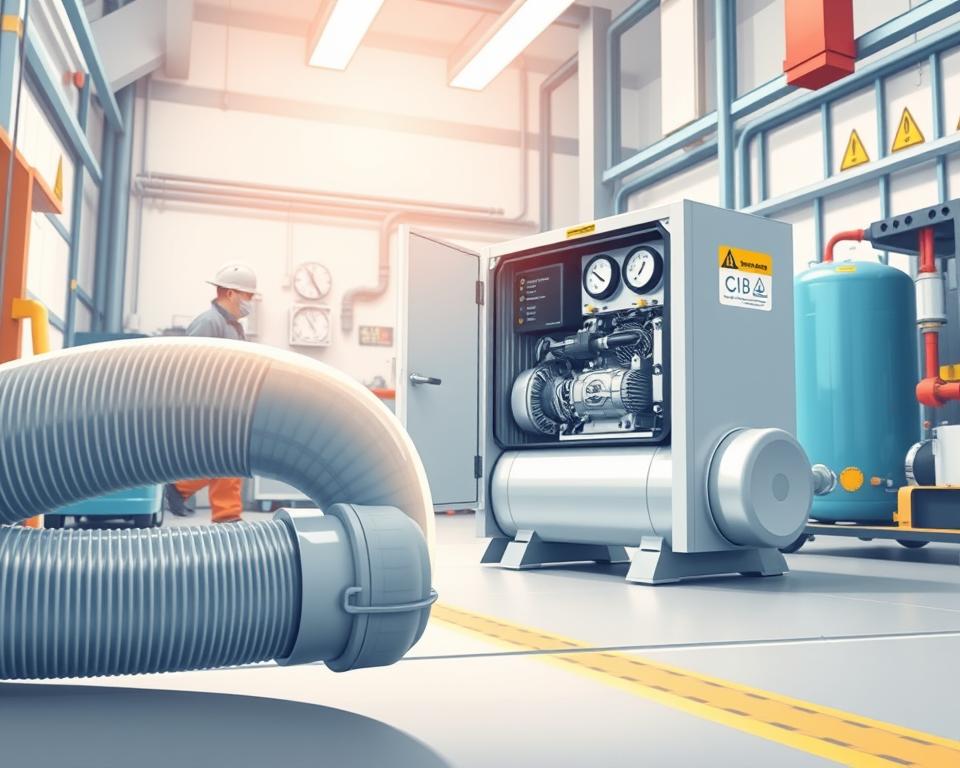PVC Pipe for Air Compressor Lines: Your Complete Guide
Did you know that a ruptured compressed air system can release energy equivalent to a stick of dynamite? Despite the hazards, numerous workshops continue installing piping systems from unsafe materials. Here’s why you must prioritize safety over cost when selecting PVC air hose.
Despite growing interest in certain materials, OSHA strictly prohibits their use in above-ground applications. Over time, exposure to oils and temperature changes weakens them, leading to catastrophic failures. Safe-rated pressures can still result in deadly bursts.
Turn to Installation Parts Supply for sturdy aluminum systems. Spending on the right materials prevents OSHA penalties and protects employees. Here’s how to assemble a risk-free system.

Significant Notes
- Explosion danger leads OSHA to outlaw some pipe materials.
- Temperature changes can halve pressure ratings.
- Material becomes brittle with age, upping rupture chances.
- Aluminum lines deliver a far safer option.
- Invest wisely to dodge fines and protect staff.
Why You Shouldn’t Use PVC for Compressed Air
PVC makers caution never to employ it in high-pressure air setups. Compressed air carries destructive energy; a burst is like a dynamite blast. This makes material choice critical for safety.
- Brittleness: Below-freezing conditions render PVC dangerously brittle.
- Adhesive failures: Oil contamination and heat cycles break down glue bonds.
- Misleading ratings: Ratings halve by 110°F, a common shop temperature.
OSHA cites a $110,000 fine after a facility’s piping shattered, injuring workers. The “heat of compression” further reduces safe operating limits, a factor often overlooked in ratings.
“Above-ground use of certain plastics for compressed air violates OSHA standards due to explosion risks.”
Steel and aluminum curve under stress instead of shattering. Plastic shrapnel from explosive failures can travel over 50 feet, embedding in walls or equipment.
Workshops face daily temperature fluctuations that accelerate material degradation. A decade’s UV and chemical attack weakens plastic, so small leaks too often balloon into disasters.
Best Materials Instead of PVC for Air Lines
Aluminum piping systems outperform traditional options in both safety and efficiency. With 90% fewer leaks than black pipe, they’re a top choice for modern facilities. Their lightweight design and corrosion resistance make them ideal for long-term use.
Modular aluminum setups save time—no threading required. Installation Parts Supply stocks ready-to-snap aluminum modules. One auto factory trimmed labor hours by 40% via aluminum retrofits.
- Copper: Best for cleanrooms due to natural antimicrobial properties. Requires soldering expertise.
- Stainless Steel: In seaside shops, stainless steel won’t corrode.
- ABS/HDPE: For solvent-rich environments, ABS/HDPE stays intact.
“Our aluminum retrofit reduced energy waste by 15%—paying for itself in 18 months.”
Don’t ignore torque specs. Too tight splits fittings; too loose lets air escape. Aluminum fittings generally torque to 25–30 ft-lbs—follow the guide.
NSF-approved lines keep food-grade air clean. Always match materials to your environment’s demands.
How to Choose the Right Piping Material for Your Needs
Selecting the best material for your setup requires balancing cost, safety, and efficiency. A Midwest factory saved $12,000 annually by switching to leak-resistant aluminum. Here’s how to make the right choice.
| Material | Cost (per ft) | Maintenance | ROI Time |
|---|---|---|---|
| Aluminum | $8.50 | Low | 18 months |
| Black Pipe | $5.00 | High | N/A |
| Copper | $10.20 | Medium | 24 months |
Temperature matters. Plastics fail under 32°F; aluminum works from -40°F to 200°F. For chemical-heavy environments, stainless steel resists solvents.
Pro Tip: Use leak-loss math to estimate ROI. A 10% leak in a 50 HP system wastes $3,500 yearly.
- Match PSI ratings to your compressor’s output.
- Verify your system meets OSHA welding and pressure-test rules.
- Request a free system audit from Installation Parts Supply.
“Our aluminum retrofit cut energy waste by 15%—paying for itself in 18 months.”
Hire pros for big installs to guarantee airtight connections. Check warranties—some pipes include decade-long coverage.
As a Final Point
Choosing the right materials for your compressed air setup isn’t just about cost—it’s about safety. Older systems account for 92% of accidents due to degraded piping. Aluminum offers 99.8% reliability, making it a smart long-term choice.
Remember:
- Never use pipes that can fragment violently.
- Opt for corrosion-resistant metals like aluminum or stainless steel.
- Non-compliant systems risk OSHA fines and insurance issues.
Ready to upgrade? Grab same-day pricing and deals on kits from Installation Parts Supply. Download our free maintenance template or call for emergency replacements.
Invest in secure lines now to protect your crew.